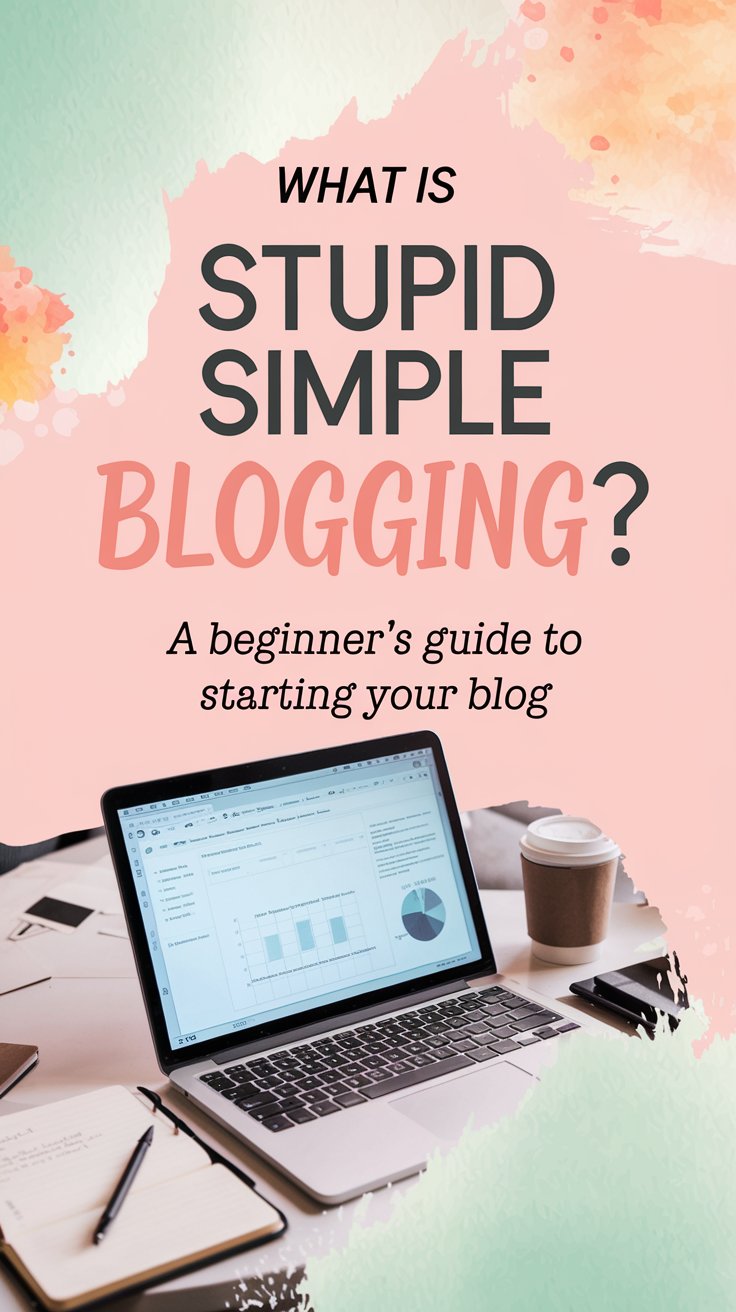Starting a blog can feel overwhelming, but it doesn’t have to be complicated. That’s where the Stupid Simple Blogging course comes into play. It’s all about cutting through the noise and focusing on straightforward, effective steps to kickstart your blogging journey.
Whether you aim to share your passion or build an online business, this method helps you get started without overthinking. No fluff, no unnecessary jargon—just a clear and concise course, that is a simplified path to launching your blog today.
The only course you will need to create, grow, and monetize your blog in a few short months. You will learn everything from how to start, how to do keyword research, how to use social media for organic traffic, and much more. The definitive full blogging training program for bloggers, with over 4,000 students enrolled. Join the waitlist to get notified when we open backup.
Read More About Blogging:
What is Stupid Simple Blogging?
Stupid Simple Blogging is a no-nonsense course to help you create, grow, and monetize your blog. It strips away the complexities and focuses on what truly counts—getting your ideas out there in the simplest way possible. This course was created by Mike Futia who is the creator of the popular SEO course “Stupid Simple SEO“. You can read my review here about the course.
Whether you’re a total newbie or just tired of overcomplicating things, Stupid Simple Blogging makes blogging easy, approachable, and achievable.
Breaking Down the Concept: The ‘Stupid Simple’ Philosophy
At its core, the “Stupid Simple Blogging” course is about avoiding unnecessary bloat. Many blogging courses and guides overwhelm you with endless steps, jargon, and tech-heavy decisions. Stupid Simple Blogging course says, “No thanks.” Instead of worrying about the perfect theme or ideal monetization strategy, it starts with the essentials:
- Focus on content: Your thoughts, your knowledge, your value. That’s all readers care about.
- Keep tools and platforms simple: Fancy tools are optional. Free, straightforward platforms like WordPress or Blogger are just fine.
- Set realistic goals: Forget becoming an overnight millionaire. Aim for progress, not perfection.
Think of it like baking a cake. You don’t need high-end gear or a Michelin-star-level recipe to bake something delicious. A few eggs, some sugar, and a working oven will do. Stupid Simple Blogging follows the same logic—minimal fuss, maximum results.
Why It Works for Beginners
If you’re new to blogging, it’s easy to feel paralyzed by decisions. Which platform is best? Should you write for SEO or personal enjoyment? Stupid Simple Blogging shines because it cuts through all that noise and provides a clear path forward.
- No tech barriers: You don’t need coding skills or expensive software. A keyword research tool and some curiosity can get you started.
- Reduces overthinking: Instead of analysis paralysis, you focus on taking action—creating posts, publishing, and learning.
- Quick start: You see tangible results faster, which keeps you motivated.
- Low cost: Forget major investments. Stupid Simple Blogging leverages free or low-cost tools such as KeySearch and PinClicks to build your site and grow your audience.
Imagine trying to learn piano. A complicated approach throws music theory at you immediately, while a simple approach starts with pressing a few keys. Stupid Simple Blogging is that simple approach for blogging—it teaches you to take one step at a time, building your skills as you go.
For more tips on why keeping it simple works, check out Benefits of Blogging – My Wolf Design Inc..
The Building Blocks of Blogging
When starting a blog, it’s easy to get stuck on decisions. But with Stupid Simple Blogging, the process is broken down into manageable steps. Below, we’ll cover the foundational elements that simplify the journey, from picking your topic to essential blogging tools.

Choosing a Niche
Your niche is the foundation of your blog. It defines what topics you’ll cover and attracts a specific audience. Picking a clearly focused niche makes it easier to grow your blog and stand out in a crowded space.
Here are some simple tips for choosing your niche:
- Follow your passion: What topics excite you? Writing about something you love ensures you’ll stay motivated.
- Research demand: Look for subjects that people are already searching for online (tools like Google’s Keyword Planner can help).
- Evaluate competition: Some niches are oversaturated. You’ll have an easier start in a less crowded space.
For more insight, check out this guide on the importance of finding your blogging niche.
Selecting a Platform
Choosing the right blogging platform is like picking the car you’ll drive on this journey. A user-friendly platform makes publishing and managing your blog much easier for beginners.
Popular options include:
- WordPress.org: Highly customizable (and recommended) with thousands of plugins and themes. Ideal for long-term growth.
- WordPress.com: A simpler, free version of WordPress. However, it comes with fewer customization options.
- Free platforms like Blogger or Wix: These are beginner-friendly but may not provide the same level of control as WordPress.org.
WordPress often stands out because of its flexibility and ease of use. Curious about the best options? Explore this list of beginner-friendly blogging platforms.
Securing a Domain Name and Hosting
Your domain name (e.g., yourblogname.com) is your blog’s online address, and hosting is where your content lives. Picking the right domain and host ensures your blog is professional, fast, and reliable.
Tips for a great domain name:
- Keep it short and memorable (avoid long, complicated names).
- Use keywords that represent your niche. For instance, a food blog could use “DelishEats.com.”
- Stick to a “.com” extension—it’s what most people recognize and trust.
When it comes to hosting, look for reliable and affordable packages. Bluehost and Hostinger are excellent options for beginners. This article on choosing the perfect domain name will help you narrow it down.
Essential Tools You’ll Need
Blogging doesn’t require dozens of tools, but having a few essentials can make your life easier. These tools help with writing, SEO, and even design.
Here’s a quick list of must-haves for beginners:
- Keyword research tools: Pinclicks or Ahrefs let you find topics people care about.
- Writing tools: Grammarly and RightBlogger keeps your writing professional and error-free.
- Design tools: Canva and Ideogram AI are great for creating eye-catching graphics and blog visuals.
- SEO plugins: If you’re using WordPress, RankMath is a must for optimizing your posts.
- Lasso: It’s a great and easy-to-use plugin for your affiliate links.
- Clicky: Analytics software is much easier to understand than Google Analytics.
Explore more beginner blogging tools here. Using the right tools not only saves you time but also boosts the quality of your blog.
Now that you’ve got these foundational steps in place, you’re ready to dive into the fun part: creating content. With these building blocks, you’re already ahead of the game.
Creating Content the Simple Way
Creating content can feel daunting, especially when you’re just starting. But with the right approach, it becomes surprisingly simple. The key is to strip it down to its basics—understanding your audience, choosing easy-to-read formats, crafting strong headlines, and ensuring your posts provide real value. Let’s break it down step by step.
Understanding Your Audience
Before putting pen to paper (or fingers to keyboard), think about your audience. Who are they? What problems are they facing? Great content speaks directly to these questions. Imagine you’re chatting with a friend—how would you explain your topic to them?
Here are simple ways to learn about your audience:
- Ask them: Use polls on social media or forums to discover what topics interest them.
- Analyze competitors: Check out similar blogs and identify what resonates with their readers.
- Use Google Trends and Keyword Planner: These tools reveal what’s currently popular or highly searched in your niche.
By addressing your readers’ pain points and desires, you’re not just writing—you’re solving problems. This connection builds loyalty and keeps readers coming back for more.
For some inspiration, see this guide on refining your content for readers.
Formats to Focus On
Not all blog formats require hours of work. Certain styles are naturally easier to produce while still being effective. Keep it simple, and focus on what works best for your audience.
Here are three easy formats to consider:
- How-tos: Step-by-step breakdowns of tasks or processes. These are practical and always in demand.
- Listicles: Organized lists like “Top 10 Tips” or “5 Reasons To Try X.” Readers love their skimmable format.
- Personal stories: Share relatable experiences to add authenticity and personality to your content.
For example, a food blogger might write a “how-to” on making sourdough bread, a “listicle” of cozy fall recipes, or a personal story about learning to cook. These formats are simple to execute and connect well with readers, starting meaningful conversations.
See examples in this step-by-step blog format guide.
Crafting Headlines That Grab Attention
Your headline is the first thing readers notice—and it can make all the difference. A great headline is like a storefront display, enticing people to step in and take a look.
Here are quick tips for writing compelling headlines:
- Be specific: Instead of “Tips for Beginners,” say “10 Simple Blogging Tips for Beginners.”
- Use numbers: Headlines with numbers get more clicks. For instance, “7 Productivity Hacks for Bloggers.”
- Promise value: Highlight the benefit, e.g., “How to Save Hours When Writing Blog Posts.”
Still unsure? Tools like CoSchedule’s Headline Analyzer can help you refine your titles. Remember, a clear and engaging headline is your ticket to grabbing attention in a crowded space. For more tips, check out this guide to writing blog headlines.
Keeping Your Posts Actionable
It’s one thing to inspire readers, but it’s another to give them something concrete to take away. Actionable posts leave readers feeling like they’ve gained something valuable—whether it’s a new skill, a fresh idea, or a solution to a problem.
Here’s how to make your posts actionable:
- Include step-by-step instructions: Break down processes so readers know exactly how to apply what they’ve learned.
- Add examples: Use real-world scenarios to clarify your points.
- Finish with takeaways: End sections with a recap of key actions readers can implement immediately.
Think of your blog post as a recipe. Don’t just describe the dish—provide the ingredients and instructions to create it. When readers can turn your advice into results, they’ll trust your content and become loyal followers.
Explore this simple guide to crafting engaging posts for more actionable tips.
By focusing on these no-nonsense methods, creating blog content doesn’t have to be complicated. Stick to what works, write for your audience, and focus on delivering value—it’s that simple.
Driving Traffic to Your Blog
Once you’ve set up your blog, the next challenge is getting people to see it. Driving traffic doesn’t have to be a mystery or a massive undertaking. With a few straightforward strategies, you can attract readers and build a steady audience without feeling overwhelmed. Let’s break this down into actionable steps.
Using Basic SEO Effectively
SEO doesn’t have to be complicated to be effective. By mastering a few simple techniques, you can boost your blog’s visibility on search engines and get more organic traffic.
Here are a few beginner-friendly SEO tips:
- Choose the right keywords: Use tools like RightBlogger or PinClicks(Pinterest keyword search tool) to find terms your audience is searching for.
- Place keywords naturally: Incorporate them into your blog title, headings, and text. Don’t overdo it—aim for natural placement.
- Write unique meta descriptions: This short text appears under your blog title in search results. Make it catchy and relevant to entice people to click.
- Use header tags wisely: Break your content into sections with
H1,H2, andH3tags to make it easier for readers and search engines to navigate.
Optimizing these elements is like painting a clear signpost for search engines—they’ll steer readers straight to your blog. For a beginner’s guide to SEO, visit Moz’s Beginner’s Guide to SEO.
Social Media for Beginners
Social media platforms such as Pinterest are a free and easy way to get eyes on your content. You don’t need to be an expert; just focus on being consistent and engaging. The course will show you how effectively you can bring organic traffic through email, Pinterest, and Facebook.
Here’s how to get started sharing your blog on social media:
- Pick one or two platforms: Don’t try to dominate every platform. Start with where your audience already hangs out—Facebook, Instagram, or Twitter.
- Post regularly: Aim for 2-3 posts per week that share your blog articles or other helpful content.
- Use hashtags: They help your posts get discovered by a broader audience. Research popular hashtags in your niche.
- Engage with others: Respond to comments, like posts, and share relevant content to stay active in your community.
Social media is about connection, not just promotion. Imagine it’s a party—be the person who adds value to conversations. Learn more about boosting your social media game with these social media strategies for bloggers.
Photo by Thirdman
Building an Email List
An email list is one of the most powerful tools for bloggers. It allows you to directly reach your audience, bypassing social media algorithms and search engine competition.
Here’s how to get started without getting bogged down in tech:
- Offer something of value: Create a freebie, like a simple PDF guide or checklist, in exchange for email signups.
- Sign up with an email tool: Use easy platforms like Mailchimp or ConvertKit to manage your emails.
- Place signup forms prominently: Add them to your blog’s sidebar, footer, or within your posts.
Think of your email list as your VIP club. These are the people most interested in your content, and they’re more likely to return to your blog. Learn more about why email lists are essential here.
By focusing on foundational strategies like SEO, social media, and email lists, you can steadily grow your audience without overcomplicating the process. These are the “stupid simple” methods anyone can start today.
Monetizing Your Blog
Once your blog is up and running, monetizing it can transform your passion into income. Even if you’re just starting out, there are accessible and straightforward ways to earn. Here’s how to keep things simple and effective.
Affiliate Marketing Made Simple:
Explain How to Start with Affiliate Programs and Link Them to Your Content
Affiliate marketing is one of the easiest ways to make money from a blog, and it requires minimal upfront investment. The idea is simple: recommend products or services, and earn a commission if someone makes a purchase through your referral link.
Here’s how to set up affiliate marketing for your blog:
- Choose affiliate programs that fit your niche. For instance, a fitness blogger might promote workout gear or supplements.
- Sign up for programs. Amazon Associates, ShareASale, and ClickBank are great starting points.
- Integrate links naturally into content. Avoid spammy placements. Instead, write honest product reviews or helpful guides while sprinkling in your affiliate links.
For example, if you’re writing a post on “Best Budget Laptops for Students,” linking directly to a product on Amazon using your affiliate code makes sense. Readers win with helpful info, and you earn when they buy.
For more tips, check out this step-by-step affiliate marketing guide.
Selling Digital Products:
Discuss User-Friendly Platforms for Creating and Selling Ebooks or Guides
Digital products are another hassle-free way to make money. Ebooks, printable planners, and photography presets are popular examples. Why? Because they’re easy to create once and sell repeatedly with no inventory!
Getting started simplified:
- Create your product. Use tools like Canva or Ideogram AI for visually appealing designs or Google Docs for straightforward, text-based content.
- Choose a platform. Gumroad, Shopify, and Sellfy are beginner-friendly marketplaces. These platforms handle the heavy lifting, like payment processing and file delivery.
- Promote it on your blog. Add banners, include product links in relevant posts, or feature them on your homepage for maximum visibility.
Platforms like Gumroad enable you to upload digital content and sell directly to your audience. This guide on selling digital downloads provides a deeper dive into platform options.
Ad Revenue Basics:
Describe How Ads Work and Simple Steps to Start Earning from Them
Ads are another classic way bloggers monetize. While they’re less personal than affiliate marketing, they can generate a steady income stream, especially as your traffic grows.
How do they work? Advertisers display banners or text links on your site, and you get paid:
- Per click (CPC): You earn every time someone clicks an ad.
- Per thousand impressions (CPM): You’re paid for every 1,000 views the ad receives on your blog.
Getting started is easy even for beginners:
- Sign up for ad networks like Google AdSense. They connect you with advertisers and simplify the process.
- Place ad code on your site. Most platforms provide a snippet of code you paste into your blog.
- Optimize for user experience. Avoid overwhelming readers with too many ads. Strategically place them where they won’t disrupt your content.
If you’re just starting out, focus on growing your traffic first. Ads work best when paired with steady, consistent web traffic. Explore this beginner’s guide to Google AdSense for more.
Photo by Burst
With these methods, you can start earning from your blog today. Focus on one or two that align with your content and grow from there. Keeping it simple ensures you won’t get overwhelmed while still maximizing your blog’s monetization potential.
Blogging Mistakes to Avoid
When starting your blog, simplicity is your best friend. But even with the “stupid simple” approach, there are mistakes that can trip you up. Here are three common pitfalls to avoid if you want to grow your blog effectively and stress-free.
Overcomplicating the Process
One of the fastest ways to stall your blogging progress is by overthinking every detail. Many aspiring bloggers feel the need for the perfect design, flawless content, or top-notch features. The truth? Perfectionism kills productivity.
Instead of obsessing over minor details, focus on launching content. A simple, functional blog can do wonders. Think about it like finding a basic car that runs well—you can always upgrade later, but it gets you where you need to go.
Here’s how to keep things straightforward:
- Start with a basic layout. Skip the fancy features until you build traction.
- Set deadlines. Give yourself a timeframe to publish each post, even if it’s not perfect.
- Focus on creating value. Readers care more about what you say than how your site looks.
Remember, blogging is a marathon, not a sprint. Progress beats perfection every time. For more insights on streamlining your blog, check out 15 Blogging Mistakes to Avoid.
Photo by Mikhail Nilov
Ignoring Analytics
How do you know if your blog is working? That’s where analytics come into play. Too many beginners skip this step and end up guessing what content their audience likes. Without data, it’s like driving blindfolded—not exactly ideal for getting somewhere fast.
Blog analytics offer valuable insights into traffic, audience behavior, and the performance of your posts. Use this data to see what’s working and where to improve.
Here’s how to get started:
- Set up Google Analytics: It’s free, and integrating it with your site takes minutes.
- Track key metrics: Monitor page views, bounce rates, and time spent on pages.
- Use tools wisely: Tools like Jetpack Analytics give you beginner-friendly reports.
By keeping tabs on your numbers, you’ll know which topics resonate, when to post, and how to optimize your strategy. To learn more, visit Blog Analytics: Top KPIs and Tools.
Giving Up Too Soon
Blogging success doesn’t happen overnight—it’s like planting a garden. You won’t see blooms immediately, but consistent effort pays off over time. Far too many bloggers quit after just a few months when they don’t get instant results.
Here’s the reality: building a blog audience requires patience. The internet is full of competition, but persistence is your secret weapon.
Here’s why you should keep going:
- Growth is slow but steady. Expect small wins like higher engagement or improved traffic over time.
- Consistency builds trust. Readers are more likely to return if they see you’re committed.
- Results compound. Each post you publish adds up to a larger body of work.
Your success might be just around the corner, but you’ll never know if you give up early. Keep at it, and remind yourself why you started.
For more tips on staying motivated, check out 16 Blogging Mistakes to Avoid.
Avoiding these simple mistakes helps set a strong foundation for your blog. Remember, simplicity and consistency are the keys to lasting success.
Conclusion
Stupid Simple Blogging strips down the process of starting a blog to its most essential steps. By focusing on easy-to-follow methods, you remove unnecessary stress and get straight to making an impact. With the right tools, simple strategies, and a clear mindset, anyone can start blogging today.
Now’s the time to take action. Start small, stay consistent, and focus on progress over perfection. The sooner you put your ideas out there, the closer you’ll be to building something meaningful.
What are you waiting for? Your blog is just one step away. Get started and keep it simple.












